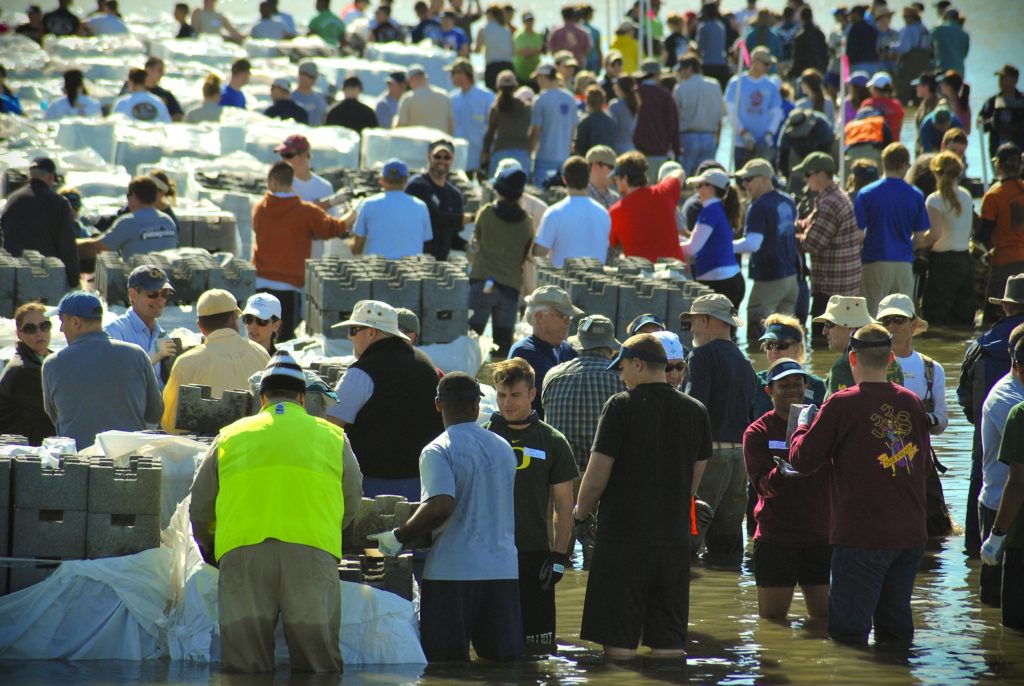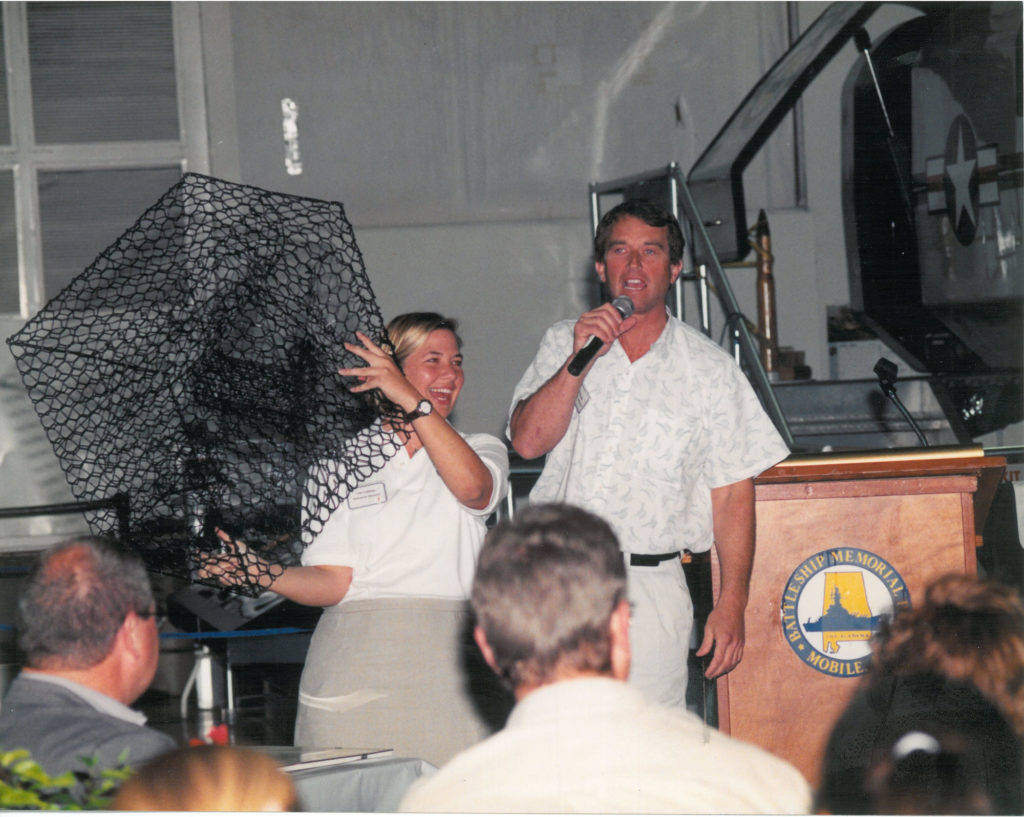Coastal Alabama on their Minds
By: ajcarapella
By Hanlon Walsh, communications coordinator at Mobile Baykeeper
Founded by persons of property, expanded by disaster, Mobile Baykeeper is an improbable success story.

The founding story of Mobile Baykeeper bears a stark contrast to that of many other Waterkeepers throughout the world. It wasn’t founded by commercial fishermen trying to reclaim their river and restore their livelihoods (as was the case with the first Waterkeeper organization, Hudson Riverkeeper) or by fierce environmental advocates who had years of experience fighting for clean water. Or by persons who considered themselves environmentalists at all.
“I think the thing that sets us apart from most other environmental organizations is that we were founded by a group of politically conservative waterfront property owners who cared about their health, their kids being able to swim in Mobile Bay, the quality of their seafood, and their property values” says Baykeeper and Executive Director Casi Callaway, who has led the organization and its predecessor for 19 years.
Leading the charge in the mid-1990s was Jack V. Greer, a prominent, well-respected businessman with a home on a peaceful stretch of the western shore of Mobile Bay, far removed from more tourist-ridden destinations of Coastal Alabama such as Gulf Shores and Orange Beach. Now 90, he still resides there with his wife Janice, and can vividly recall the early days of what was then known as West Bay Watch. Greer and a small group of other concerned residents mobilized when plans were announced for the construction of a chemical plant near his family’s home.
“The ‘powers that be’ announced they were going to take over the entire western shore of Mobile Bay for industrial development, primarily for chemical companies,” says Greer. “They wanted the eastern side of the bay to be residential, and this side of the bay to be solely industrial.”
Plans were laid for the construction of a sewage-outfall pipe, 80-feet long and 40-feet wide, to be built two miles from the mouth of Fowl River, a 14.4-mile-long brackish river that discharges into Mobile Bay and is lined with both full-time and vacation homes.
“Some folks on Fowl River got word of this announcement and began to call each other up to spread the news,” says Greer.
This grassroots group, known as the Fowl River Protective Association, began holding regular meetings at a nearby church and formed into West Bay Watch in 1997. As they investigated the environmental implications of those chemical plants, they discovered that Mobile County’s economic policy had encouraged industry for decades, and that the Environmental Defense Fund ranked Mobile County first in the nation for the presence of chemicals linked to reproductive and developmental disorders, and fifth in those known to be cancerous hazards.
Logan Gewin, another founding member of West Bay Watch, who later succeeded Greer as president, remembers driving near the one industrial site on the western shore where chemical plants had already been built, and “seeing all of those smoke stacks in the air, and wanting to know if it was safe to breathe. At the time it was a few decision-makers who were trying to decide the future of this area. One day, we agreed that it was time to draw the line and tell them we didn’t want any more of these chemical plants coming here.”
In 1998, the growing organization changed its name to Mobile Bay Watch, and expanded its mission to address air- and water-quality issues on both the east and west sides of the bay. But demands were such that many of the volunteers couldn’t keep up with the workload, as they juggled their commitment with those to families and full-time careers. Jean Downing, a founding member who worked tirelessly alongside Gewin to establish credibility for the organization in the first few years, remembers the moment she realized they needed to hire a staff person: “I came to the point and thought – I can’t do this anymore,” she said. “There were too many things that came up that were slipping through the cracks, and we knew it was time for someone who could take this job on full-time.”

They hired Casi Callaway as the first full-time director of West Bay Watch, and shortly thereafter applied for and received non-profit status. Callaway, who today also serves as the chair of Waterkeeper Alliance’s Waterkeeper Council, had recently moved back to the Mobile area after working for Clean Water Action in Washington, D.C. for eight years. She knew that she faced a different kind of battle in her politically conservative, industry-minded hometown, where most residents viewed environmentalists as left-wing extremists.
“People down here didn’t like the word ‘environmentalist,’” she recalls, “but many of them were proud conservationists who were hunters and fisherman with families who spent their summers on Mobile Bay. It was just a matter of showing people that we were all on the same team, whether or not they realized it at the time.”
In September 1999, Mobile Bay Watch affiliated with Waterkeeper Alliance, and then changed its name to Mobile Baykeeper.
“When we joined Waterkeeper Alliance,” says Callaway, “I realized I had a larger family and they gave me the tools I needed to better understand our issues and translate them for our politically conservative climate.”
Shortly afterward, Rick Dove, the founding Neuse Riverkeeper, traveled down from North Carolina to conduct a site-visit. Mobile Baykeeper at the time was in a fierce battle with a chemical company, and Callaway was being sharply criticized and accused of being opposed to job creation. She will always remember advice that she received from Dove.
“Rick said, ‘Casi, your job isn’t to fight for jobs. Your job is to fight for Mobile Bay. If you don’t step up and do something, then who’s going to?” Nearly 17 years later, Callaway evokes these words as a mantra whenever she encounters opposition.
Such inspiration and encouragement helped carry Mobile Baykeeper through some significant milestones. In 1999, it filed its first lawsuit, against the Mobile Area Water and Sewer System (MAWSS) for violations under the Clean Water Act, after it discovered that MAWSS had been spilling 2.5 million gallons of raw sewage into the bay annually.
“One of the very first things we knew we were going to have to deal with was sewage,” says Callaway. “Sewage spills kept occurring because MAWSS was putting Band-Aids on the system and not making the types of upgrades that were critical to prevent more spills.”
After nearly two years of negotiations, the parties reached a settlement that markedly improved the way MAWSS would operate. Under its terms, the agency was required to make a significant investment to upgrade infrastructure, an amount that has now reached nearly $200 million. And remarkably, what had started as a lawsuit eventually turned into a partnership.
Shortly after the settlement, the two organizations joined in a fight against the Alabama Department of Transportation (ALDOT), which in 2004 had proposed construction of a new highway that would cross nine streams within the Big Creek Lake Reservoir, Mobile’s primary source of drinking water.
“The whole situation was a giant mess,” says Callaway. “They hadn’t even conducted an environmental impact statement and were allowing massive amounts of red clay to be dumped in our drinking-water supply.”
After years of litigation, the partnership settled with ALDOT in 2007, exacting tightened rules regarding the amount of dirt that could be uncovered while building new roads, as well as more stringent statewide stormwater regulations.
“Collaboration has been behind every successful campaign we have won,” Callaway says. “This was such a unique scenario, that despite being in a previous lawsuit with MAWSS, we were able to work together and win a huge battle that saved the drinking-water supply for hundreds of thousands of our citizens.”
Notable as these victories were, arguably the most significant event in Mobile Baykeeper’s history occurred after the explosion aboard a BP Deepwater Horizon oil-drilling rig on April 20, 2010, which killed 11 workers. Immediately after the spill, Callaway was unsure as to how it would affect Alabama’s Gulf Coast until she heard disturbing news from other Waterkeeper groups who had experience dealing with oil spills, including Casco Baykeeper in Maine, San Francisco Baykeeper and Cook Inletkeeper in Alaska.
“We learned that because they waited seven days to burn the oil, it was going to be a massive spill,” says Callaway. In fact, it became the worst environmental disaster in U.S. history. “One day it was leaking 5,000 gallons a day, then the next day it would be 25,000 gallons a day, and so on.”
This would continue for 87 days, until the well was finally capped on July 15th. By then, more than 200 million gallons of oil had been released. During those months, Mobile Baykeeper’s tireless response and restoration plan drew national attention, as well as financial support that allowed it to double its budget and staff.
Though the BP disaster occurred more than seven years ago, Baykeeper is still very much engaged in restoration efforts throughout coastal Alabama. “We have a lot of money coming to the Gulf Coast that needs to be spent wisely on projects that restore and enhance what was lost,” says Callaway. “We’re working hard to make sure that the majority of funds go toward projects that will make us resilient enough to withstand the next disaster, manmade or natural.”
With a full-time staff of eight, a 19-member board of directors, more than 4,500 members and an annual operating budget of nearly $700,000, Baykeeper, once viewed by many as a radical clique, is now considered a trusted environmental watchdog and informed voice of reason.
“Twenty years ago, we were way behind the rest of the country,” says Logan Gewin. “What Casi and Mobile Baykeeper have done over the years is bring the issues of clean water and protection of our natural resources to the forefront of our community.”
Jean Downing, who still monitors industrial projects near her home on the western shore and regularly communicates with the Baykeeper staff, couldn’t agree more. “Today,” she adds, “when there are environmental questions that come up in our community, people know they have a trusted resource to call on – and that’s Mobile Baykeeper.”
As it has developed, however, Mobile Baykeeper’s mission has remained the same–to protect the beauty, health, and heritage of its watershed and Alabama’s coastal communities. Given the recent shift in political administrations, Callaway knows that she and her staff will have to walk a thin line amid politically conservative supporters in a “red” state. But this is a challenge she is all too familiar with.
“Our members know that our waterways are integral to our economic vitality, our community strength, and our success,” she concludes. “We must continue emphasizing that clean water is a non-partisan issue and remind them that we need their support now, more than ever.” W
Hanlon Walsh is the communications coordinator at Mobile Baykeeper